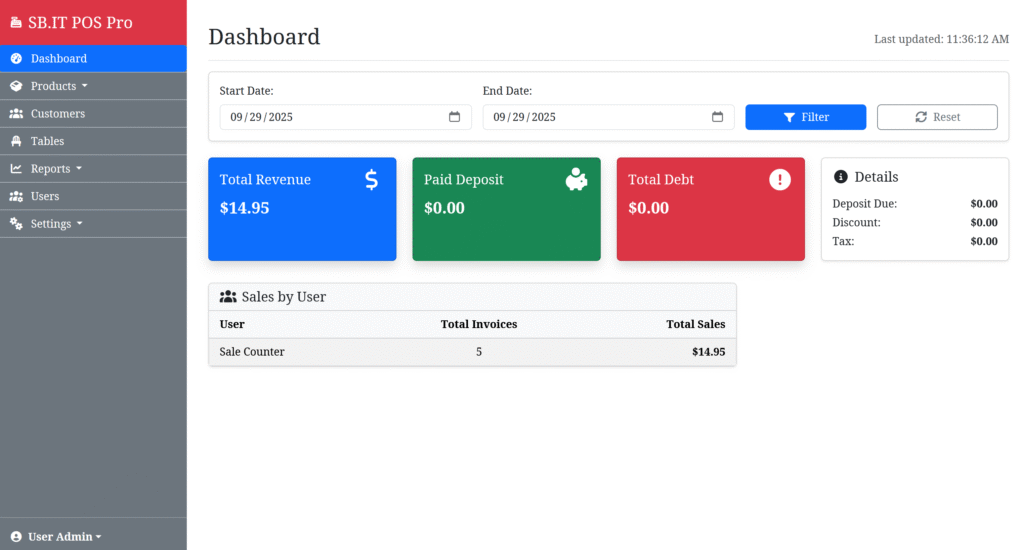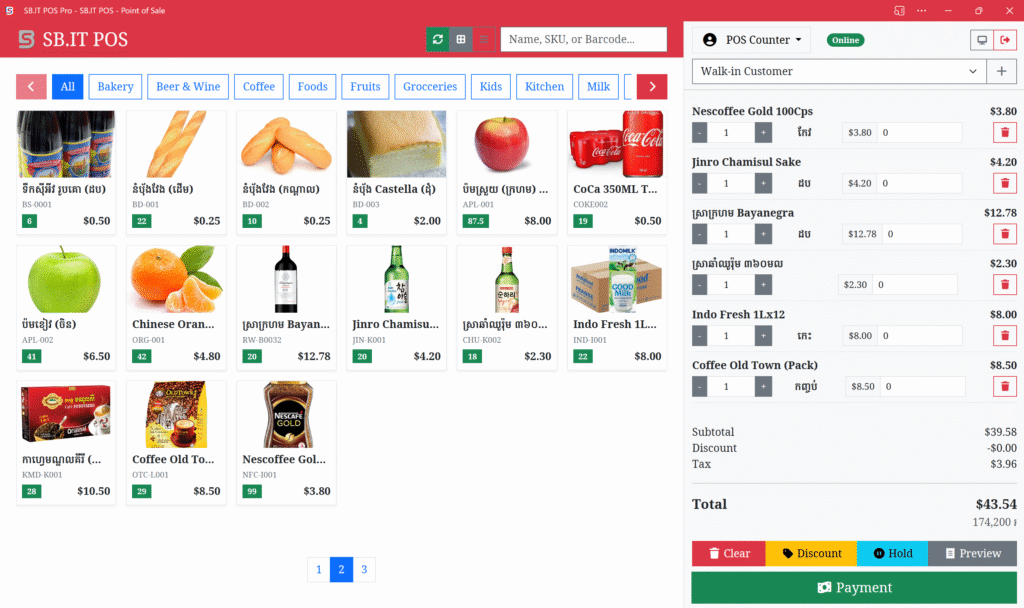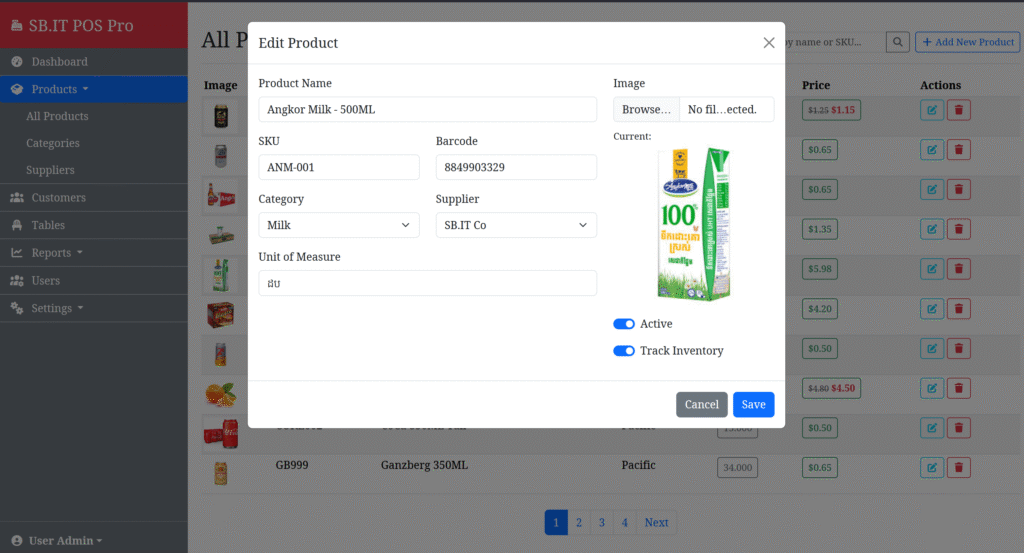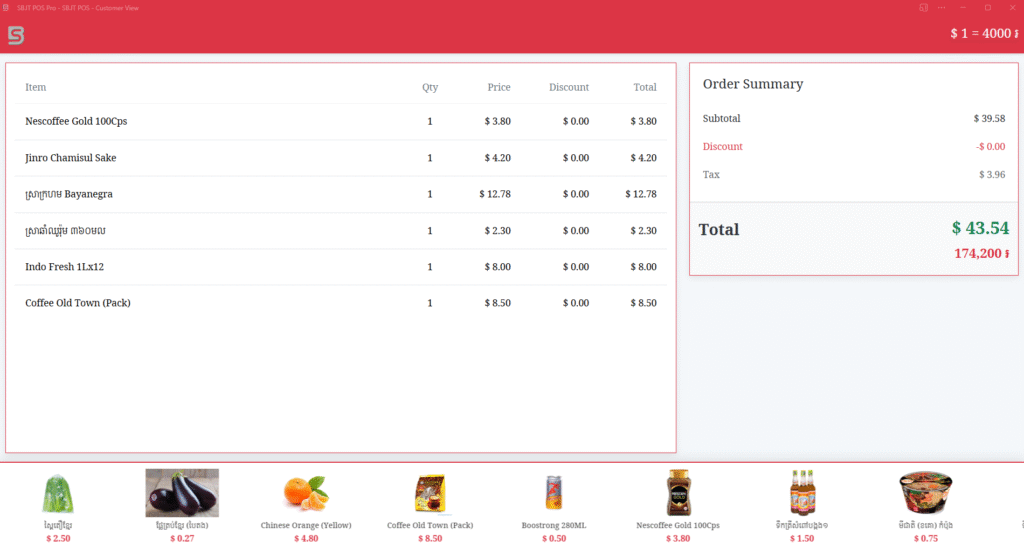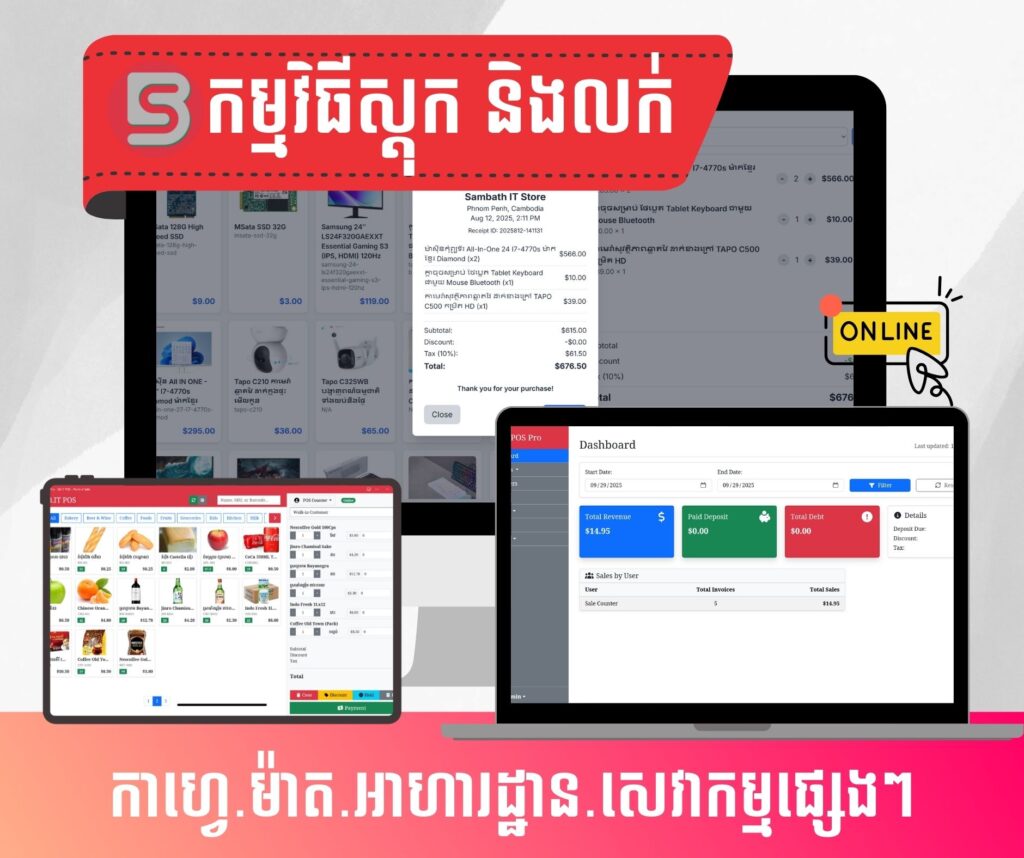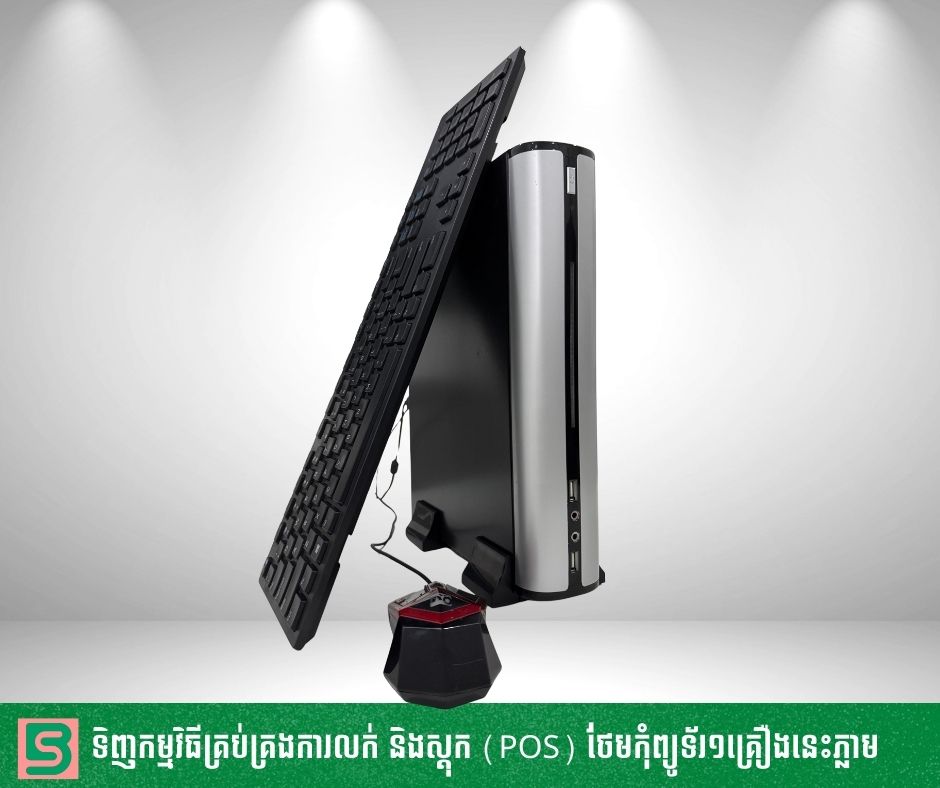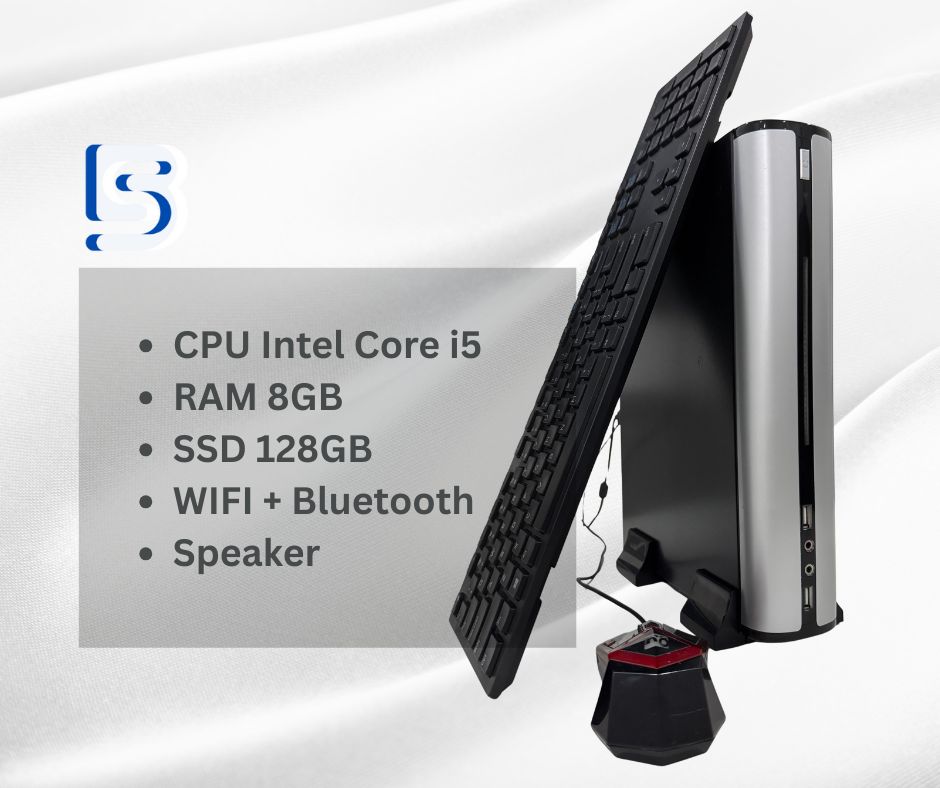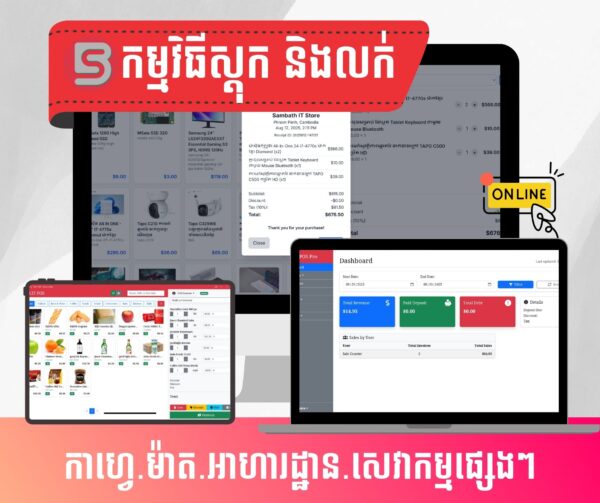កម្មវិធីដែលផលិតដោយអ្នកជំនាញខ្មែរ មានបទពិសោធន៌ផ្នែក ផលិតកម្មវិធីគ្រប់គ្រងស្តុក ខ្នាតតូច និងធម្យម ជាង១០ឆ្នាំ។
អាចប្រើប្រាស់ Online, Offline ឬ Offline-First បន្ទាប់មកផ្ទេរទិន្នន័យ Online អាស្រ័យលើចំណងចំណូលចិត្ត និងភាពចាំបាច់ប្រើប្រាស់។ អាចផ្លាស់ប្តូរទិន្នន័យ ពី Offline ទៅ Online បានដោយពុំបារម្ភការបាត់បង់។
ទាំងការលក់តាមហាងទូទៅ ហាងកាហ្វេ និងអាហារដ្ឋាន សុទ្ធតែអាចផ្លាស់ប្តូរមុខងារបានគ្រប់ពេលវេលា និងងាយស្រួលជាទីបំផុត ដោយមិនចាំបាច់តម្រូវតម្លើងកម្មវិធីជាថ្មីឡើយ។
ដំណោះស្រាយសម្រាប់អាជីវកម្មខ្នាតតូច និងធម្យម ដែលមានដូចជា អាហារដ្ឋាន ហាងទំនិញទូទៅ ហាងកាហ្វេ ហាងផ្តល់សេវាកម្មផ្សេងៗ។ នេះគឺជាកម្មវិធី ដែលផលិតនៅក្នុងស្រុក មិនផ្តល់ផលរំខានចំពោះការគាំទ្រ ឬការផ្តល់ដំណោះស្រាយ ពេលមានបញ្ហាផ្សេងៗ។ កម្មវិធី SB.IT POS Pro 2025 គឺជាកម្មវិធីប្រើប្រាស់ប្រព័ន្ធអនឡាញ ងាយស្រួលគ្រប់គ្រង ងាយស្រួលមើលទិន្នន័យ តាមកុំព្យូទ័រ និងថេបប្លែត។ ផលិតដោយ Sambath IT Computer Solutions។
ជម្រើសល្អបំផុតសម្រាប់អាជីវកម្មដូចខាងក្រោម៖
- ហាងលក់ទំនិញរាយ និងដុំទូទៅ
- ហាងកាហ្វេខ្នាតតូច និងធម្យម
- ហាងអាហារខ្នាតតូច និងធម្យម
- ហាងសេវាកម្មផ្សេងៗ
ហេតុអ្វីត្រូវជ្រើសរើសកម្មវិធី SB.IT POS Pro 2025?
- គ្រប់គ្រងតាមប្រព័ន្ធអនឡាញ មិនបារម្ភរឿងទិន្នន័យបាត់បង់
- តម្លៃទាបបំផុត និងការផ្តល់សេវាកម្មថែទាំភ្លាមៗ ព្រោះជាផលិតផលខ្មែរ
- អាចកែសម្រួល តាមតម្រូវការអតិថិជន
- ប្រព័ន្ធគ្រប់គ្រងទំនិញ តម្លៃដើម តម្លៃលក់ ប្រវត្តិកែប្រែតម្លៃ តម្លៃមុន និងក្រោយ
- ប្រព័ន្ធតាមដាន ការលក់ ប្រចាំថ្ងៃ ទំនិញលក់ដាច់ជាងគេ
- គ្រប់គ្រងអតិថិជន (សម្រាប់ហាងទំនិញបោះដុំ ឬមិនទទួលភ្ញៀវចូល)។ ជំពាក់ សង កាត់ទូទាត់ សងម្តងទាំងអស់ សងតាមវិកយប័ត្រ។ មើលរបាយការណ៌អតិថិជន ដើមគ្រា និងចុងគ្រា។
- គ្រប់គ្រងការចំណាយទូទៅប្រចាំថ្ងៃ ផ្ទៀងផ្ទាត់ និងប្រាក់ចំនេញពីការលក់ ស្វែងរកប្រាក់ចំនេញសុទ្ធ
- គ្រប់គ្រងរបាយការណ៌របស់អ្នកលក់ របាយការណ៌អតិថិជន
- ស្វែងរកទំនិញដែលលក់ដាច់ជាងគេ (វាយតម្លៃទីផ្សារ)
- ប្រព័ន្ធគ្រប់គ្រងអ្នកលក់ខាងមុខ (វេនចេញនិងចូល) របាយការណបិទបញ្ចីរ
- ផ្ញើការលក់ភ្លាមៗទៅកាន់ តេឡេក្រាម
- ការលក់អាចទូទាត់ (កត់ចំណាំ) តាមធនាគារ និងប្រាក់សុទ្ធ ជំពាក់ ឬបានបង់មុន
- បោះពុម្ពវិក័យបត្រតាមកម្រិត ខ្នាតតូច 80mm, A5 និង A4 (អាចជ្រើសរើសបាន)
- អាចទាញយករបាយការណ៌លក់ របាយការណ៌ស្តុក របាយការអតិថិជន តាមរយះ Excel និង PDF លឿន ងាយស្រួលកែសម្រួល។
ទំនាក់ទំនងដើម្បីធ្វើតេស្តជាក់ស្តែង
តេឡេក្រាម សូមចុចតីនេះ!
Join Channel : https://t.me/sbitpc
មុខងារសំខាន់ៗដែល SB.IT POS Pro 2025 កំពុងមាន
គ្រប់គ្រងពីចម្ងាយ
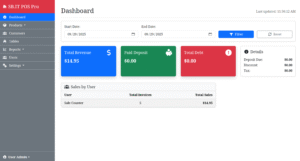
- មើលរបាយការណ៌សង្ខេបប្រចាំថ្ងៃ ខែ ឆ្នាំ
- បញ្ចូលទំនិញ ពីចម្ងាយ
- ទទួលសារភ្លាមៗពេលធ្វើប្រត្តិបត្តិការណ៌លក់
- គ្រប់គ្រងម៉ោងចូល និងម៉ោងចេញ
- បិទបញ្ចីរពេលចេញ
- មើលរបាយការណ៌អតិថិជន (ជំពាក់ សង)
- មើលប្រត្តិបត្តិការណ៌ចំណូល
គ្រប់គ្រងស្តុកទំនិញ
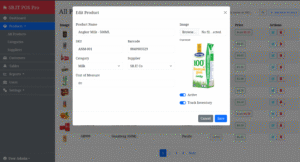
- គ្របគ្រងផ្នែក
- គ្រប់គ្រងតម្លៃទិញចូល តម្លៃលក់ចេញ តម្លៃចុះ
- ប្រវត្តិកែប្រែតម្លៃ (តម្លៃដើម តម្លៃលក់)
- បញ្ចូលលេខកូដ បារកូដ រូបភាពទំនិញ
- កំណត់តាមដានស្តុក ឬមិនតាមដាន
- បិទ ឬបើក មិនឲ្យលក់
ប្រព័ន្ធលក់ងាយស្រួល
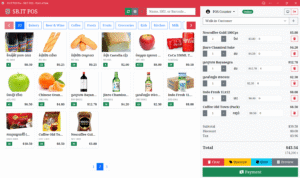
- ប្រព័ន្ធគិត TAX (បិទ ឬបើកបាន)
- ប្រព័ន្ធចុះតម្លៃ (Discount)
- ប្រព័ន្ធរងចាំ (Hold) គិតលុយអ្នកបន្ទាប់សិន
- កំណត់ចំណំាការទូទាត់ (ប្រាក់សុទ្ធ, ធនាគារ, ជំពាក់ ឬបង់មុន)
គ្រប់គ្រងតុ (អាហារដ្ឋាន និងកាហ្វេ)
- គ្រប់គ្រងតុ (កក់ទុក រវល់ និងទំនេរ)
- ចេញបុងគិតលុយ
- បន្ថែម បន្ថយ ការកុម្ម៉ង់បានងាយស្រួល
- ប្រព័ន្ធលក់ ដូចគ្នា
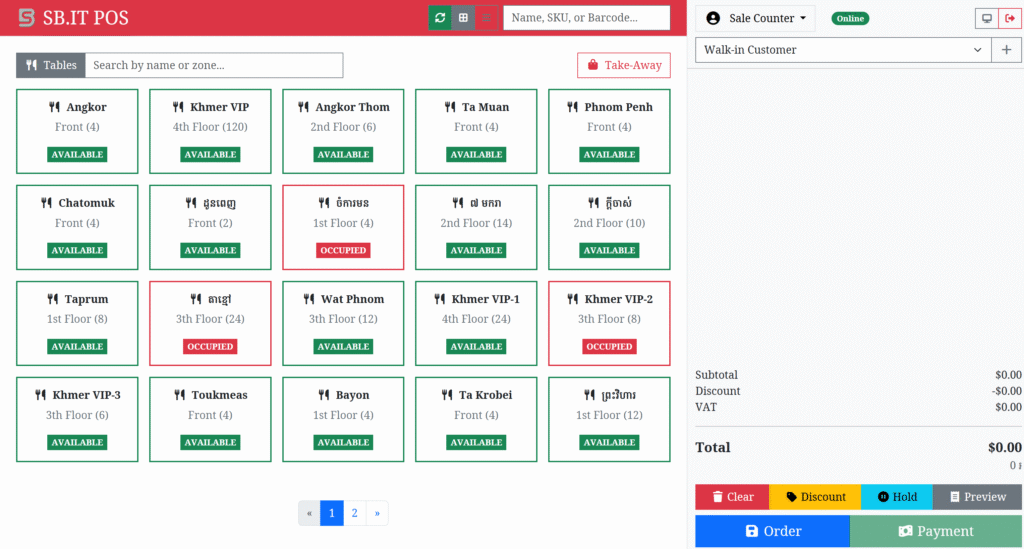
ផ្ទាំងបង្ហាញពត៌មានអតិថិជន (ខាងមុខ)
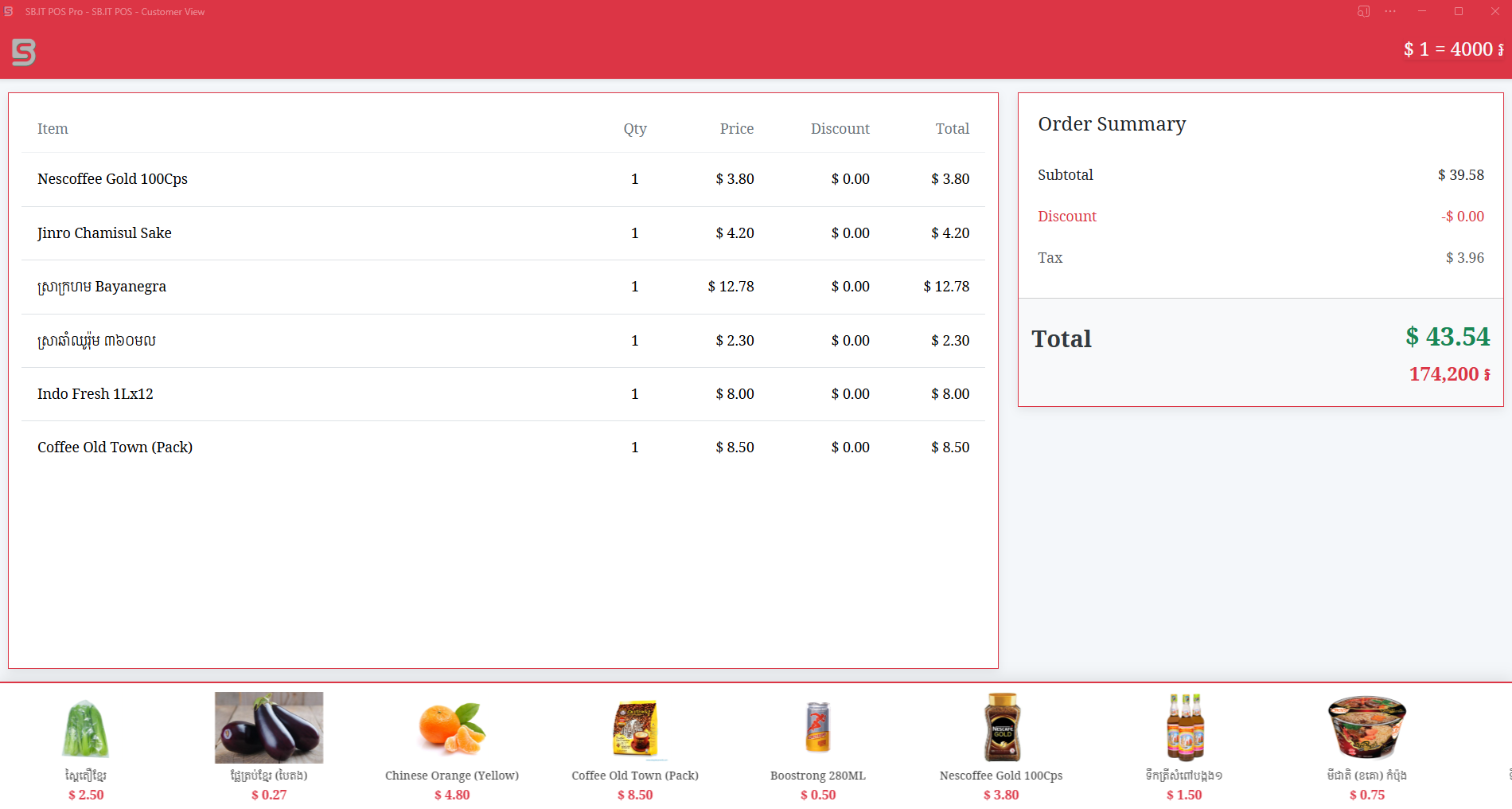
តម្លៃ ការផ្តល់ជូន និងការធានា
តម្លើងដាច់ (Offline)
290 USD
- ការតម្លើងកញ្ចប់ពេញ Offline
- មិនតម្រូវប្រព័ន្ធអិនធើណិត
- មិនកំណត់អ្នកប្រើប្រាស់
- តម្លើងឃ្លាំងទិន្នន័យលើម៉ាស៊ីនឯកជន
- បង្រៀនប្រើប្រាស់ឥតគិតថ្លៃ
- ដោះស្រាយបញ្ហាបច្ចេកទេស១ឆ្នាំឥតគិតថ្លៃ
ថែមជូនកុំព្យូទ័រ១គ្រឿងភ្លាមៗ (ចំនួនមានកំណត់)
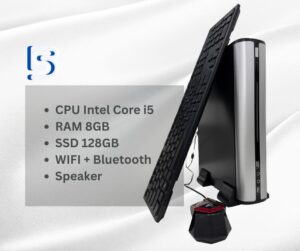
ប្រចាំខែ (Online)
ទិន្នន័យ 9 USD ក្នុង១ខែ
តម្លៃកម្មវិធី (ទូទាត់តែមួយដង) 245 USD
- តម្លើងកញ្ចប់ពេញ Online
- តម្រូវការប្រព័ន្ធអិនធើណិត (ពេលដាច់ក៏អាចប្រើបាន) លើកលែងអាហារដ្ឋាន។
- មិនកំណត់អ្នកប្រើប្រាស់
- តម្លើងឃ្លាំងទិន្នន័យ លើអិនធើណិត (9 USD ប្រចាំខែ)
- បង្រៀនប្រើប្រាស់ដោយឥតគិតថ្លៃ
- ដោះស្រាយបញ្ហាបច្ចេកទេស១ឆ្នាំឥតគិតថ្លៃ
- ធ្វើកំនែ Version ថ្មី (បើមានតម្រូវការ) ឥតគិតថ្លៃ
ប្រចាំឆ្នាំ (Online)
ទិន្នន័យ 99 USD ក្នុង១ឆ្នាំ
តម្លៃកម្មវិធី (ទូទាត់តែមួយដង) 245 USD
- តម្លើងកញ្ចប់ពេញ Online
- តម្រូវការប្រព័ន្ធអិនធើណិត (ពេលដាច់ក៏អាចប្រើប្រាស់បាន) លើកលែង អាហារដ្ឋាន។
- មិនកំណត់អ្នកប្រើប្រាស់
- តម្លើងឃ្លាំងទិន្នន័យ លើអិនធើណិត (99 USD មួយឆ្នាំ)
- បង្រៀនប្រើប្រាស់ដោយឥតគិតថ្លៃ
- ដោះស្រាយបញ្ហាបច្ចេកទេស១ឆ្នាំឥតគិតថ្លៃ
- ធ្វើកំនែ Version ថ្មី (បើមានតម្រូវការ) ឥតគិតថ្លៃ
ថែមជូនកុំព្យូទ័រ១គ្រឿង (ចំនួនមានកំណត់)

ទិញ ឬជូនដំណឹងមកកាន់យើងខ្ញុំដើម្បីសាកល្បងឥឡុវនេះ!
POS Software កម្មវិធីគ្រប់គ្រងការលក់ និងស្តុក
ហាងលក់ទំនិញរាយ និងដុំទូទៅ
ហាងកាហ្វេខ្នាតតូច និងធម្យម
ហាងអាហារខ្នាតតូច និងធម្យម
ហាងសេវាកម្មផ្សេងៗ
ទំនាក់ទំនងយើងខ្ញុំឥឡូវនេះ

